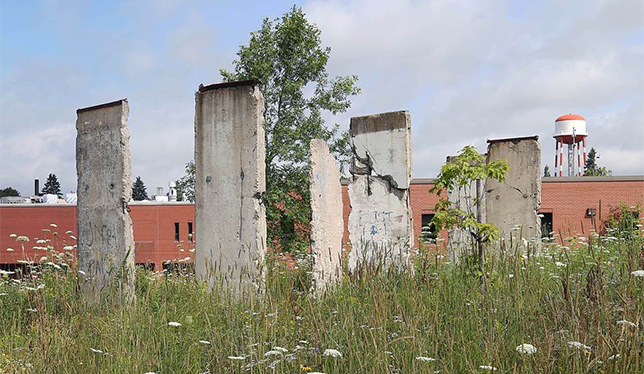
After the Berlin Wall fell in 1989, a new, lesser-known chapter in its history began. Many large slabs, not to mention plenty of rubble-turned-souvenirs, began to circulate around the world, landing in various places—everywhere from dresser drawers and presidential libraries to museums, hotel lobbies, eBay and even a vacant lot in downtown Truro, Nova Scotia.
More than 25 years on, two Ryerson University professors in the School of Image Arts, Blake Fitzpatrick and Vid Ingelevics, are trying to track down and document the movement of the wall, in photographs and video, from Berlin to North America. “We refer to it as tracing a mobile ruin,” says Dr. Fitzpatrick, “We are interested in the backstory of how these objects actually get to where they are, and why.”
The researchers are especially keen on documenting slabs, like the set purchased by a Maritime entrepreneur and brought to Truro, that continue to move around. “Some of the local merchants complained that they were really an eyesore,” says Dr. Fitzpatrick, referring to the installation in Truro. “There was an instant movement to get rid of them.”
Soon after the professors’ Truro visit, they learned the pieces were being moved from their downtown site to a butterfly meadow tucked behind Dalhousie University’s agricultural college about 4 km away in Bible Hill, N.S. “In a strange way it’s more appropriate, though it’s still wildly out of context,” says Mr. Ingelevics, “But that’s true of every piece of wall in North America. They are all decontextualized to some degree.”
What they found most interesting about the new Dalhousie site is that the panels are not placed in a straight line, but rather are staggered, creating an archaic, sculptural feel, almost like Stonehenge. “It points to the multiple levels, or registers, at which the wall exists,” says Mr. Ingelevics.
He says the narrative most commonly attached to the wall is, not surprisingly as a Cold War trophy; but they’ve also noticed the way that the graffiti-covered pieces have taken on new esthetic meaning as art objects. “The fact that the Truro pieces were not particularly well-covered with paintings is perhaps what allowed the new custodians a little bit more freedom,” says Dr. Fitzpatrick. “They’ve been a little bit more interpretive with the objects than most places.”
The project, which began in 2003, grew out of questions the two professors wished to explore about the afterlife of iconic structures. “There’s a universal aspect that’s pointing to missing and absent histories that’s always been part of our work in other projects,” says Mr. Ingelevics, who was grateful for SSHRC funding that allowed them to spend time in Berlin during the celebrations marking the 25th anniversary of the fall of the wall in 2014. While the project, by its very nature, has no end, it will culminate with a summary project and website under the title, “Freedom Rocks: The everyday life of the Berlin wall.” Dr. Fitzpatrick says they are also hoping to organize an exhibition at a Toronto gallery, with some smaller installations elsewhere in the city. “Art work, just like the Berlin Wall,” he says, “always has a life after itself.”-Shawna Wagman
I was fortunate to be in Berlin 3 days after reunification. I have a small bag of pieces of the wall thanks to some industrious Germans who sought to take advantage of the situation and chip away at the wall – then capitalize by selling small pieces. Nothing spectacular about the pieces, themselves, more the memory of standing beside the wall as they were chipping away and handed me the plastic bag of pieces. This project of yours looks so interesting – I’ll be sure to follow your progress and pubs.
Just visited the Newseum in Washington DC. They have 5 (consecutive?) pieces and a tower from the wall, as well as a block they encourage visitors to touch.
What a fascinating idea for a research project! A good many pieces of the wall remain in Berlin, serving variously as historical artifacts or as objets d’art, depending on their location and appearance (their physical arrangement, and the amount of graffiti or other artwork on the wall slabs). There is also one small stretch of the wall that is still standing in its original location, as a reminder. Two years ago in Berlin I purchased postcards that have little plastic receptacles embedded in them that enclose tiny pieces of the wall. As a flourishing branch of Ostalgie, the sale of pieces of the Berlin Wall has no doubt attracted some entrepreneurs who were less than scrupulous about the authenticity of what they were selling as pieces of the wall. I wonder if there is any means of authenticating what was actually once part of the Berlin Wall, as opposed to ‘fake’ pieces of concrete purporting to be historical artifacts?